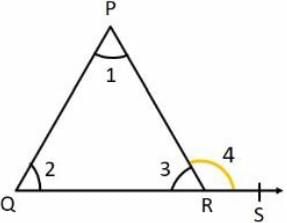Class 9 Exam > Class 9 Questions > The exterior angle of a triangle is equal to ...
Start Learning for Free
The exterior angle of a triangle is equal to the sum of two
- a)alternate angles.
- b)interior angles
- c)exterior angles
- d)interior opposite angles
Correct answer is option 'D'. Can you explain this answer?
Most Upvoted Answer
The exterior angle of a triangle is equal to the sum of twoa)alternate...

∠1 + ∠2 + ∠3 = 180o (Angle sum property)....(a)
∠3 + ∠4 = 180o (Linear Pair)....(b)
On equating equations a and b, we get
∠1 + ∠2 = ∠4
Free Test
FREE
| Start Free Test |
Community Answer
The exterior angle of a triangle is equal to the sum of twoa)alternate...
Exterior Angle of a Triangle:
The exterior angle of a triangle is formed by extending one of the sides of the triangle. It is the angle formed between the extended side and the adjacent interior angle.
Explanation:
To understand why the correct answer is option 'D', let's consider the properties of alternate angles, interior angles, exterior angles, and interior opposite angles in a triangle.
1. Alternate Angles:
Alternate angles are formed when a transversal intersects two parallel lines. In a triangle, there are no parallel lines present, so the exterior angle cannot be equal to the sum of alternate angles.
2. Interior Angles:
Interior angles are the angles formed inside the triangle. The sum of the interior angles of a triangle is always 180 degrees. Therefore, the exterior angle cannot be equal to the sum of interior angles.
3. Exterior Angles:
The exterior angle of a triangle is formed by extending one of the sides of the triangle. It is the angle formed between the extended side and the adjacent interior angle. The exterior angle is always equal to the sum of the two opposite interior angles.
4. Interior Opposite Angles:
Interior opposite angles are the angles formed inside the triangle, opposite to the exterior angle. The sum of the interior opposite angles is always equal to the exterior angle.
Therefore, the correct answer is option 'D' - the exterior angle of a triangle is equal to the sum of the two interior opposite angles. This property holds true for all triangles.
The exterior angle of a triangle is formed by extending one of the sides of the triangle. It is the angle formed between the extended side and the adjacent interior angle.
Explanation:
To understand why the correct answer is option 'D', let's consider the properties of alternate angles, interior angles, exterior angles, and interior opposite angles in a triangle.
1. Alternate Angles:
Alternate angles are formed when a transversal intersects two parallel lines. In a triangle, there are no parallel lines present, so the exterior angle cannot be equal to the sum of alternate angles.
2. Interior Angles:
Interior angles are the angles formed inside the triangle. The sum of the interior angles of a triangle is always 180 degrees. Therefore, the exterior angle cannot be equal to the sum of interior angles.
3. Exterior Angles:
The exterior angle of a triangle is formed by extending one of the sides of the triangle. It is the angle formed between the extended side and the adjacent interior angle. The exterior angle is always equal to the sum of the two opposite interior angles.
4. Interior Opposite Angles:
Interior opposite angles are the angles formed inside the triangle, opposite to the exterior angle. The sum of the interior opposite angles is always equal to the exterior angle.
Therefore, the correct answer is option 'D' - the exterior angle of a triangle is equal to the sum of the two interior opposite angles. This property holds true for all triangles.

|
Explore Courses for Class 9 exam
|

|
Similar Class 9 Doubts
Question Description
The exterior angle of a triangle is equal to the sum of twoa)alternate angles.b)interior anglesc)exterior anglesd)interior opposite anglesCorrect answer is option 'D'. Can you explain this answer? for Class 9 2025 is part of Class 9 preparation. The Question and answers have been prepared according to the Class 9 exam syllabus. Information about The exterior angle of a triangle is equal to the sum of twoa)alternate angles.b)interior anglesc)exterior anglesd)interior opposite anglesCorrect answer is option 'D'. Can you explain this answer? covers all topics & solutions for Class 9 2025 Exam. Find important definitions, questions, meanings, examples, exercises and tests below for The exterior angle of a triangle is equal to the sum of twoa)alternate angles.b)interior anglesc)exterior anglesd)interior opposite anglesCorrect answer is option 'D'. Can you explain this answer?.
The exterior angle of a triangle is equal to the sum of twoa)alternate angles.b)interior anglesc)exterior anglesd)interior opposite anglesCorrect answer is option 'D'. Can you explain this answer? for Class 9 2025 is part of Class 9 preparation. The Question and answers have been prepared according to the Class 9 exam syllabus. Information about The exterior angle of a triangle is equal to the sum of twoa)alternate angles.b)interior anglesc)exterior anglesd)interior opposite anglesCorrect answer is option 'D'. Can you explain this answer? covers all topics & solutions for Class 9 2025 Exam. Find important definitions, questions, meanings, examples, exercises and tests below for The exterior angle of a triangle is equal to the sum of twoa)alternate angles.b)interior anglesc)exterior anglesd)interior opposite anglesCorrect answer is option 'D'. Can you explain this answer?.
Solutions for The exterior angle of a triangle is equal to the sum of twoa)alternate angles.b)interior anglesc)exterior anglesd)interior opposite anglesCorrect answer is option 'D'. Can you explain this answer? in English & in Hindi are available as part of our courses for Class 9.
Download more important topics, notes, lectures and mock test series for Class 9 Exam by signing up for free.
Here you can find the meaning of The exterior angle of a triangle is equal to the sum of twoa)alternate angles.b)interior anglesc)exterior anglesd)interior opposite anglesCorrect answer is option 'D'. Can you explain this answer? defined & explained in the simplest way possible. Besides giving the explanation of
The exterior angle of a triangle is equal to the sum of twoa)alternate angles.b)interior anglesc)exterior anglesd)interior opposite anglesCorrect answer is option 'D'. Can you explain this answer?, a detailed solution for The exterior angle of a triangle is equal to the sum of twoa)alternate angles.b)interior anglesc)exterior anglesd)interior opposite anglesCorrect answer is option 'D'. Can you explain this answer? has been provided alongside types of The exterior angle of a triangle is equal to the sum of twoa)alternate angles.b)interior anglesc)exterior anglesd)interior opposite anglesCorrect answer is option 'D'. Can you explain this answer? theory, EduRev gives you an
ample number of questions to practice The exterior angle of a triangle is equal to the sum of twoa)alternate angles.b)interior anglesc)exterior anglesd)interior opposite anglesCorrect answer is option 'D'. Can you explain this answer? tests, examples and also practice Class 9 tests.

|
Explore Courses for Class 9 exam
|

|
Signup to solve all Doubts
Signup to see your scores go up within 7 days! Learn & Practice with 1000+ FREE Notes, Videos & Tests.




























